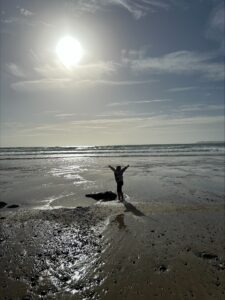Sandy Haven Pill protected by floating boom from Sea Empress oil spill
15th February 1996 is an infamous day in Pembrokeshire and one still remembered with deep sadness. It was the day the super tanker Sea Empress went onto the rocks in the entrance to the Milford Haven Waterway. Like the Torrey Canyon before her (also on route to Milford Haven), she spilled her cargo of crude oil into the protected waters of the Pembrokeshire Coast National Park, its areas of special scientific interest, as well as the many golden sand beaches popular with summer tourists. Thousands of our wild birds died horribly in the sticky stinking oil. I have read that the tanker was pushed by currents out of her course and went on to the rocks. But the sea is full of currents and modern shipping is expected to deal with these problems. The local story (which does not particularly agree with the official version) is that the Texaco oil refinery was running out of oil as the fully loaded 147,000 ton Liberian-registered super tanker Sea Empress approached the Milford Haven Waterway. The tide was going out and sea levels were not high and dropping. On board junior pilot John Pearn was told to get her in. Perhaps he cut a corner, but he left the main deep water channel and went onto the rocks at the entrance to the waterway.
Something supposedly impossible, that we the local population had been reassured could not happen, had happened. At first it was not so major, as 2,500 tonnes of crude oil escaped into the pristine waters. However because the oil industry did not consider such an accident possible, there were insufficient numbers of powerful tugs available to pull the ship off the rocks and to hold her off.
What tugs were available pulled her off, but were unable to prevent her drifting back onto the rocks and further damaging the single skin hull. It would be six days before enough powerful tugs were assembled and able to safely tow her off the rocks. By then the accident had escalated into a catastrophe, as a further 70,000 tonnes of oil escaped (her cargo was 130,000 tonnes). The leaking tanker was, surprisingly, towed into the Milford Haven Waterway to one of the oil jetties, where the remaining 58,000 tonnes of oil was pumped out. The 73,000 tonnes of escaped oil slowly spread by wind and tide along 200km of the south Wales coastline. Happily Skomer Island narrowly escaped when the wind changed direction and blew the oil away from it.
The Marine Accident Investigation Branch (MAIB) was scathing. They found the initial accident due to incompetence of junior pilot Mr Pearn, who was inadequately trained to handle such large vessels. Mr Pearn was demoted (but successfully appealed and resumed working with large tankers). Today as senior pilot he is bringing in the vast Liquid Natural Gas (LNG) tankers. The MAIB also criticised the Port Authority for the major spill, as the accident was regarded as impossible and therefore outside the scope of its emergency plans. Also because the crisis management team became too unwieldly for effective action. There were many recriminations and much arguing over some years before it all died down.
Meanwhile for the people of Pembrokeshire and south Carmarthenshire, vast stinking sheets of crude oil began washing up along 200km the pristine beaches enjoyed by thousands of tourists. People openly wept when they watched favourite beaches like Tenby’s famous North Beach with its golden sands turned into a stinking brown-black treacle-like mess with our famous sea birds dead and dying in it. Local fishermen lost their trade. Lindsway Bay was entirely engulfed in the thick oil that blanketed the surf on the beach. At the cliff top, the air as almost unbreathable with strong oil fumes. West Angle beach was cleaned, only to have the oil replaced next tide. The oil spread along the main beaches inside the Milford Haven Waterway, including Sandy Haven beach that was repeatedly contaminated by different tides each bearing oil. Happily within the waterway, the industry already had floating rubber booms for containing minor oil spills around the tankers. These were rapidly deployed to protect sensitive areas. One of these booms was placed across the entrance to Sandy Haven Pill early in the catastrophe and the pill was protected.
Despite the fact that many of the seabirds were away from Pembrokeshire on their winter migration, up to 20,000 sea birds were killed by the oil. Over 7,000 dead and oiled birds were collected by volunteers, but almost all failed to survive the cleaning process. A similar negative result was obtained for birds oiled in the 1967 Torrey Canyon disaster near the Scilly isles. The local seal population had a lucky escape, as at the time of the oil spill most were away from Pembrokeshire.
A massive clean up followed. Only 3,000 tonnes of the spilled oil was recovered. Aircraft sprayed dispersants on the oil slicks at sea. In rocky areas, pools of oil were removed by suction. Sandy beaches were cleaned by scraping off the oil with hand scrapers and mechanical diggers. Rock faces were sprayed with chemicals followed by high pressure washing. On stony beaches, the pebbles were individually wiped clean with tissues. Inaccessible coastline and beaches were not cleaned, but left to recover by natural processes. This was rapid on coasts exposed to stormy waters, but very slow on sheltered muddy shores with vegetation. It took Pembrokeshire County Council 5 years to complete the clean up and the cost was estimated to be £60 million. The beaches that had been sprayed with chemicals, over the next few years turned bright green due to excess growth of edible seaweeds. So much of the beach life had been killed, that there was little left to browse it. But ten years later things were back to normal.


